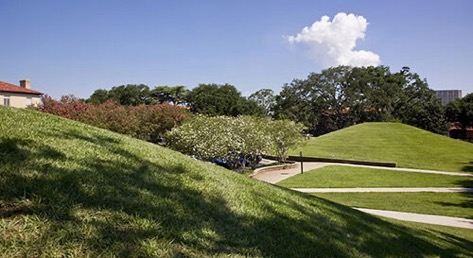Synchrotron Radiation used to analyze Core of LSU Campus Mounds
Traditionally, the central goal in archaeology is “just” the recovery, analysis, and interpretation of the material remains of past societies. This led to the fact that most people think that archaeology is directly connected to “digging”. However, today’s goals of archaeology are much broader. The include determining past functions, developing models of ancient behavior and ancient cultures, and determining how and why cultures changed. For achieving these far reaching goals, answers to the following questions, which include detailed chemical/ biological/physical analyses of the “remains” are required:
- What materials are we dealing with? (Elemental composition)
- Where is the raw material coming from? (Trace elements as fingerprint for provenance)
- How was the object fabricated/treated? (Manufacturing techniques, Utilization, Chemical state of elements)

A view of the LSU Mounds. |
In a recent publication, B.B. Ellwood et al. (2022) reported that radiocarbon dating of the two LSU Campus Mounds (16EBR6) indicates that the construction of Mound B began at ~ 11,000 BP, making this mound the oldest known man-made structure in the Americas. Ash lenses in the deeper (older) part of the mound seem to indicate that the mounds may have been used for ceremonial or cremation purposes. If correct, these findings would significantly chance the history of mound building in North America. In a critical essay, Ch. McGimsey et al. (2022) argue that there are still substantive questions regarding these claims. For resolving these issues, the authors suggest six topics that should be addressed. At least three of these that are directly connected to above questions 1 – 3 can be answered using synchrotron radiation based techniques. CAMD is involved in this project, as two synchrotron radiation based X-ray techniques are applied that will give first solid answers to the above mentioned questions. X-ray fluorescence spectroscopy (XRF) will be used for determining the elemental composition down to the ppm range of various samples from the core (Question 1). With this element distribution soil and ashes that seem to be present in the core of the mounds can easily be discriminated. |
Assuming that this element distribution is a unique fingerprint of a material (here a soil) the origin of the soil can be determined if “reference soils” from supposed origin locations are available (Question 2). Based on suitable test experiments it is also possible to determine from the XRF spectra of the ashes the type of plants and even their parts that were burnt.
X-ray absorption spectroscopy (XAS), the second technique, allows the non-destructive individual and detailed chemical/ geometric characterization of more or less all elements in a sample on the atomic level. Thus, it is possible to determine via the oxidation state (valency) of some elements (e.g. Fe and Ca) if a sample (including soil) was exposed to a high temperature, for examples by ceremonial fires on the mounds (Question 3). As compared to more standard techniques such as X-ray diffraction, X-ray absorption spectroscopy does not require “long range order” (crystallinity) but can be used also for non-crystalline or mixtures of crystalline and X-ray amorphous samples such as soil, mortar, pottery and ceramics.
For more information about the LSU campus mounds check out this page: https://www.lsu.edu/mounds/index.php